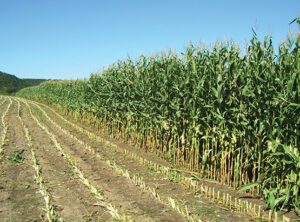Todd Schroeder set a goal to win the World Dairy Expo’s Forage Analysis Superbowl contest in 10 years. With the help of the Midwestern BioAg soil fertility program and his sales consultant Travis Klinkner, Schroeder achieved that goal last fall. It took the Cashton, Wisconsin, farmer only a few years.
In last year’s contest, the cash crop and beef farmer won the Grand Champion prize for first-time entrants and a cash award of $1,500.
Each year at the Forage Analysis Superbowl, more than $22,000 in cash prizes are handed out to top-finishing forage producers. In last year’s contest, there were 486 entries from 25 states and provinces in seven forage categories.
Schroeder raises 800 to 1,000 head each year, bringing in Angus, Simmental, Limousin, and crossbred cattle at 400 to 500 pounds and raising them to 800 to 900 pounds. He finishes 30 to 40 head each year as well.
Schroeder’s route to winning the Forage Superbowl started in 2013 with a crop of soybeans. After harvesting the beans, he planted winter rye as a cover crop to build his soil capacity. In spring of 2014, Schroeder made two passes with a McFarlane Reel Disk and no-tilled the corn.
It’s all about improving soil life to get better feed. It takes the stress off the plant and improves the soil structure.
For early-season growth, Schroeder applied both dry and liquid starter fertilizer. 19-6-14 was broadcast-applied at 410 pounds per acre and 9-10-15 was applied at a rate of 250 pounds per acre as a row-assist starter fertilizer. These dry fertilizer blends provide sulfur, calcium, magnesium, zinc, copper, manganese, iron, and boron for a more complete plant nutrition program. Schroeder also applied BioAg’s liquid, carbon-based fertilizer (L-CBF) 10-14-1 in-furrow at five gallons per acre to help stimulate soil biology.
When the corn plants reached the V 5-8 stage of growth, Schroeder side-dressed the corn with a combination of 20 gallons per acre of 28% liquid nitrogen and three gallons per acre of 10-14-1.
Combined, this fertility program provided 165-60-95-70S of nutrients per acre, including Midwestern BioAg’s proprietary trace mineral pack. Midwestern BioAg’s low-pH fertilizers go beyond standard N-P-K blends to deliver the micronutrients plants need for optimum plant health. These premium blends are especially important when growing forages. Healthy, more nutrient-dense plants produce healthier, more productive feeds.
To grow his winning silage, Schroeder planted seed from Master’s Choice, a partner of BioAg. At harvest, when Schroeder tested his side-by-side corn variety trials on the farm, Midwestern BioAg consultant Travis Klinkner noted how good that stand of corn looked and urged him to enter the contest. “I thought it would be cool to see where we compare to other growers,” Schroeder said.
He also wanted to get data on how his crops fared after only two years with the BioAg soil fertility program. “We’re seeing tremendous results. I thought I was doing a good job before, but I really feel this new program is worth the investment. We are getting better quality feed.”
He plants 50 to 60 acres of corn specifically for silage each year and another one of his goals is to surpass the neighboring dairy farmers in production. That’s another reason he likes the Forage Analysis Superbowl contest. “It’s neat to see how you compare to farmers from all over the country. I was competing with farmers from Pennsylvania to New York to Kansas.”
Schroeder likes the floury corn varieties for their improved digestibility and plants a lot of Master’s Choice 527, 5661, and 5370. He has begun aiming for more non-GMO corn varieties in order to reduce costs given the lower corn prices of $3.50 to $4.25 per bushel.
Each year he works 550 to 600 acres of land, growing corn, soybeans, and alfalfa. This year’s crop rotation includes about 220 acres of corn. Since he isn’t a dairy farmer and doesn’t spread a lot of liquid manure, he especially likes the results he’s seeing from the BioAg soil fertility program. “Yes, it’s an investment and you need to put some money into it,” Schroeder says. “But you need yield to get cash flow and I’m seeing yield improvements.” His silage varieties are making 28 to 32 tons per acre — that’s 11 tons of dry matter per acre.
“I have definitely seen the benefits of getting on the program. It’s all about improving soil life to get better feed. It takes the stress off the plant and improves the soil structure. “It’s worth the investment to get better quality feed.” On his farm, that has also translated into a new and improved cattle feeding program.
Because the World Forage Analysis Superbowl contest is held in conjunction with World Dairy Expo, one of the parameters used to measure forages is milk per ton. His winning entry measured up at 3,799 pounds of milk per ton.
He laughs at the folks who ask him how many cows he milks because he only has beef cattle. “But I figure that the starch digestibility and feed quality that allow dairy cattle to make milk are also going to give me gain for my beef cattle.”
He encourages other growers to see how their forages compare by entering the Superbowl contest. “It’s only a $25 entry fee and it really allows you to see how your forage program measures up.”

